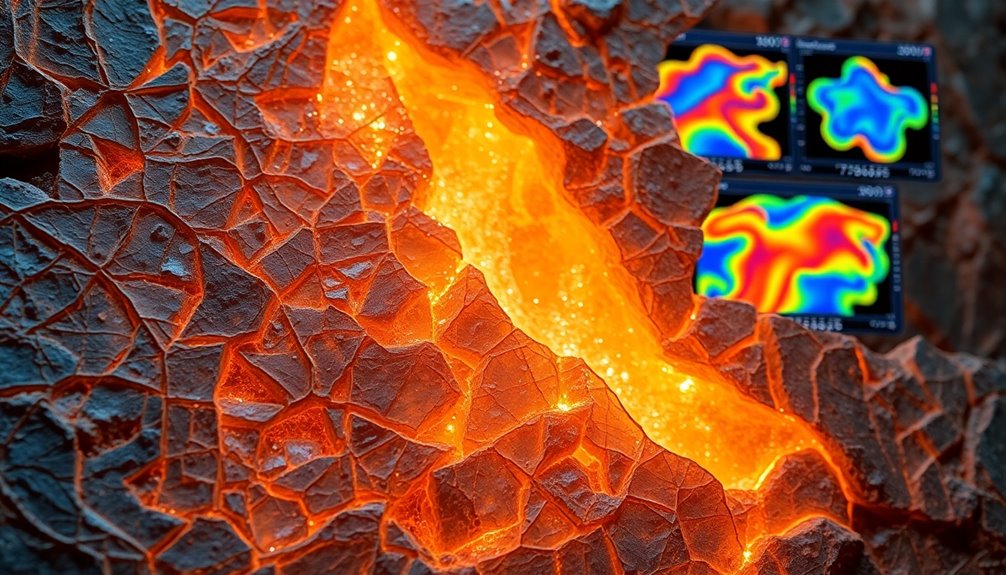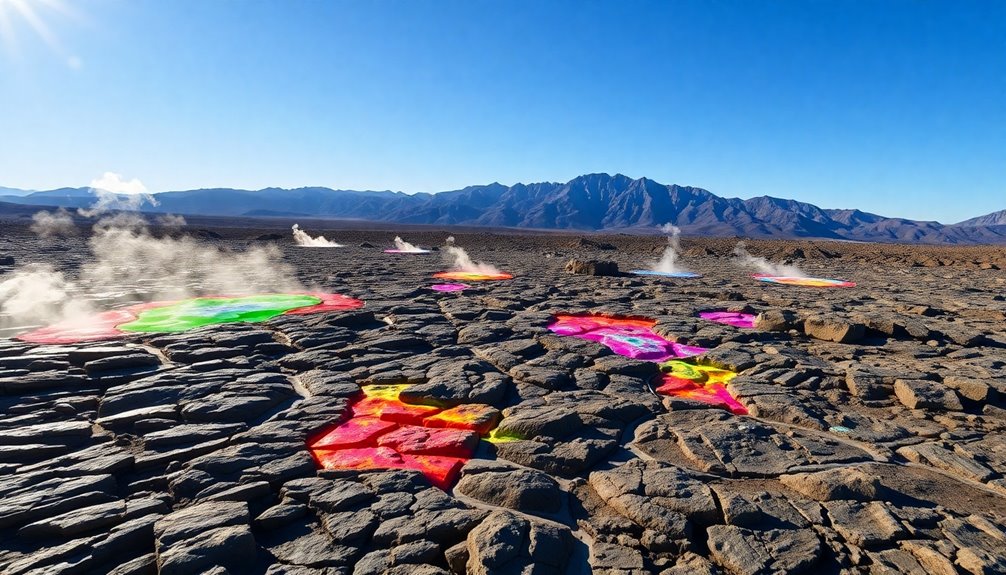Investigating fracture networks in enhanced geothermal systems is crucial for boosting heat extraction efficiency. You'll find that complex fracture geometries optimize fluid flow and maintain higher production temperatures. Using integrated simulations, you can model these intricate networks and understand their dynamics better. Discrete fracture modeling helps capture these complexities while field observations back up simulation data. As you explore further, you'll uncover valuable insights on how to enhance geothermal energy recovery even more.
Key Takeaways
- Discrete fracture modeling (DFM) effectively simulates complex fracture interactions, enhancing understanding of heat extraction in Enhanced Geothermal Systems (EGS).
- Coupled simulations integrate thermal, hydraulic, mechanical, and chemical factors, providing comprehensive insights into fracture network dynamics and performance.
- Field observations and UAV data complement simulations, improving the characterization and understanding of complex fracture networks for optimal heat extraction.
- The geometry and connectivity of fracture networks significantly impact thermal energy recovery, with intricate networks outperforming simpler configurations.
- Hydraulic aperture determination is crucial for simulating flow in fractured networks, influencing the overall efficiency of geothermal systems.

Fracture networks play a crucial role in geothermal systems, especially when it comes to enhancing heat extraction efficiency. The geometry and connectivity of these networks significantly impact how effectively you can extract heat in Enhanced Geothermal Systems (EGS). When you work with complex fracture networks that include secondary and branched fractures, you'll find they outperform simple, continuous patterns for sustainable heat extraction.
Interrupted fracture networks can maintain higher production temperatures, generating more power due to the longer flow paths they create for injected fluids. This means the more intricate the network, the more potential you have for effective thermal energy recovery. However, it's not just about the fractures themselves; the dynamics within the wells—like the injection-production pressure difference—play a crucial role in the overall efficiency of these networks.
Intricate fracture networks enhance thermal energy recovery by maintaining higher production temperatures and optimizing fluid flow paths.
To study these fracture networks, modeling approaches become essential. Discrete fracture modeling (DFM) is often the go-to choice for accurately simulating fracture behavior in EGS. This method captures the complexities of fracture interactions and helps in understanding how they influence heat extraction. Hydraulic aperture determination is crucial for simulating flow in fractured networks, which enhances the accuracy of these models.
Coupled simulations that integrate thermal, hydraulic, mechanical, and chemical factors provide insights into fracture behavior under various conditions, giving you a clearer picture of what to expect.
Characterizing these networks involves various innovative techniques. You might use unmanned aerial vehicles (UAVs) to gather data on fracture geometry from hard-to-reach locations. Additionally, well tests and geophysical surveys help identify hydraulically active fractures, enhancing your understanding of their transmissivity.
Field observations and advanced borehole logging techniques further enrich your data, allowing for a comprehensive analysis of hydraulic apertures and rock properties.
Frequently Asked Questions
How Do Fracture Networks Impact Geothermal Energy Efficiency?
Fracture networks significantly impact geothermal energy efficiency by influencing heat extraction dynamics.
You'll find that factors like fracture spacing, orientation, and permeability directly affect fluid flow and heat transfer.
More complex networks with branched fractures allow for better heat retention and stability.
What Software Tools Are Used for Simulating Fracture Networks?
When simulating fracture networks, you'll find several powerful software tools at your disposal. StimPlan is great for hydraulic fracture design, while dfnWorks and FracMan excel in creating and simulating discrete fracture networks.
These tools enable 3D simulations and integrate multiple processes, providing detailed insights. Additionally, they cater to various applications, from oil extraction to groundwater management, ensuring you can effectively model and analyze complex fracture systems in different geological contexts.
Can Fractures in Geothermal Systems Be Artificially Induced?
Yes, you can artificially induce fractures in geothermal systems using hydraulic fracturing techniques.
By injecting fluids at high pressure, you create new fractures that enhance reservoir permeability and efficiency. This process often involves applying shear stress to existing fractures, allowing for better fluid flow.
However, it's essential to monitor for potential induced seismicity and ensure effective connectivity between injection and production wells to optimize the system's performance.
What Role Does Geology Play in Fracture Network Formation?
Think of geology as the architect of fracture networks, shaping their very existence.
You'll find that tectonic stress and past geological events play pivotal roles in fracture formation. Variations in rock types and their properties can dictate how fractures develop and propagate.
Natural fractures interact with hydraulic ones, creating a complex dance influenced by the surrounding lithology.
Ultimately, geology's nuances determine the efficiency and effectiveness of these networks in various settings.
How Are Fracture Networks Monitored Over Time in Geothermal Systems?
You can monitor fracture networks over time in geothermal systems using various techniques.
Unmanned Aerial Vehicles (UAVs) capture detailed images, while microseismic monitoring tracks subsurface activity.
Seismic data analysis identifies fracture distribution, and borehole logging detects active fractures.
Additionally, well tests measure fracture conductivity and transmissivity.
Conclusion
In conclusion, understanding fracture networks in enhanced geothermal systems isn't just theoretical; it's crucial for efficient energy extraction. You might think that these networks are too unpredictable to model effectively, but integrated simulations provide valuable insights that can help us navigate this complexity. By embracing these advanced techniques, we can optimize geothermal energy production and reduce environmental impacts. Ultimately, a deeper understanding of these systems paves the way for a more sustainable energy future.









